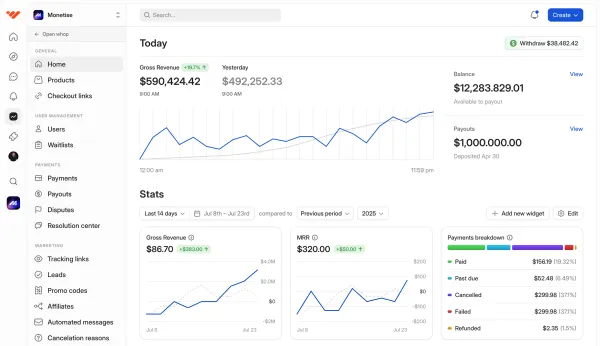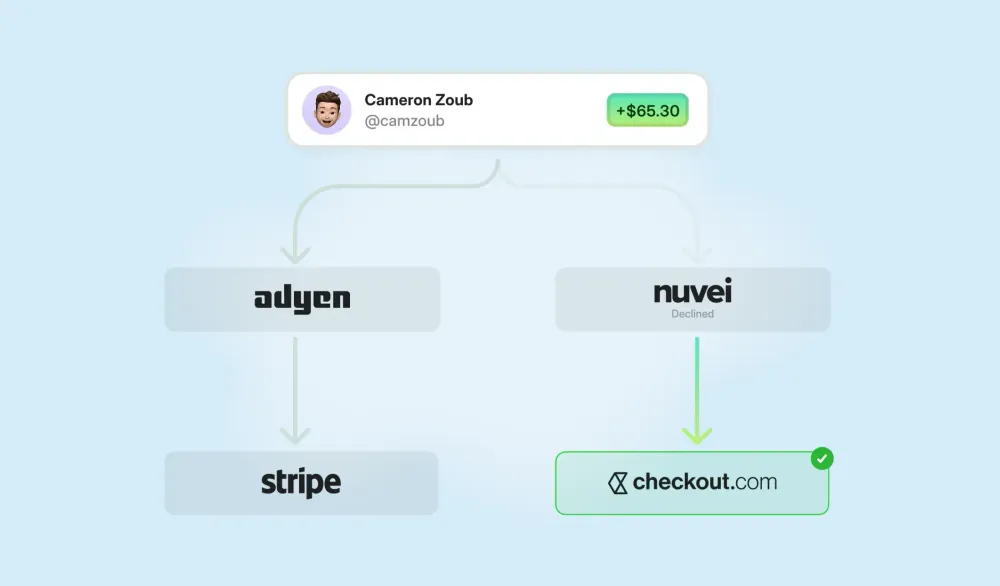You can start an online business by choosing a business model, doing market research, defining a target audience, building a brand and business plan, creating products, and setting up your online store in Whop.
Key takeaways
- Choose your business model first as it determines costs, timeline, and profit potential.
- Validate demand through market research using social media trends and competitor analysis.
- Define a niche target audience instead of trying to sell to everyone.
- Create a simple one-page business plan covering costs, pricing, and growth targets.
- Handle legal and tax requirements early to avoid penalties and headaches later.
You can start an online business by choosing a business model, doing market research, defining your audience, building your brand, creating products, and setting up your store on Whop.
That’s the simple version. But actually turning that into a business that makes money? That’s where most people fail.
I’ve watched thousands of founders spin up stores in minutes - and I’ve seen what separates the ones who grow from the ones who disappear.
So I put everything into this 10-step guide to give you the real path, plus expert tips to help you avoid common mistakes.
Starting an online business in 10 steps
1. Choose your business model
Before you start building logos, websites, or TikToks, you need to decide what kind of business you’re running.
Your business model shapes everything: how much money you’ll need, how much time it’ll take, and how fast you can make a profit.
As Justin Waller says in the video above: "You can take the same entrepreneur - same skill set, same talent, same drive - put one in vehicle A and one in vehicle B - one looks like Steve Jobs, one is bankrupt. Picking the vehicle is one of the most important things you can do before you start using that energy capital".
Here are the most common online business models:
- Ecommerce: Selling physical products through an online store (Shopify, Amazon, Etsy).
- Dropshipping: Selling products without holding inventory – suppliers ship directly to customers.
- Digital products: Think ebooks, courses, templates, memberships, or software. Low cost, scalable, beginner-friendly.
- Service-based business: Freelancing, consulting, coaching, design, marketing — you sell your skills.
- Content creation/UGC: Building an audience and monetising through ads, brand deals, or subscriptions.
- Reselling: Flipping items (clothes, sneakers, collectibles) through marketplaces like Depop, eBay, or Grailed.
Options, am I right? So where do you fit in? Well, it's best to filter your model through three lenses:
Skills required: Play to your strengths. If you’re creative, digital products or content may be the move. If you’re analytical, ecommerce or reselling could click.
Costs: Digital products and dropshipping are low-cost to start. Ecommerce with inventory or high-touch services will need more capital.
Time: Services and content are time-heavy. Digital products and dropshipping can become more passive once set up.
2. Market research & validation
Skipping market research is like building a house without checking if the land is solid. I mean, you might get lucky… But most of the time, you’ll end up sinking.
But don’t stress. Market research doesn’t have to be boring, tedious, or expensive.
Here’s how to do it without getting stuck in paralysis:
Spot the trends
Scroll TikTok, Instagram Reels, and YouTube Shorts — when people are buying or sharing something on repeat, that’s a signal.
Pay attention to the comments too. If viewers are asking where to find a product, for links, or for more information? That’s real demand, not just vanity engagement.
- Use Google Trends to see if interest is growing or dying.
- Check Reddit or niche forums to find what real communities are hyped about (often way before mainstream).
Scope the competition
Search for your idea on Google, Amazon, Etsy, or marketplaces in your niche. Are there sellers or creators already doing it? Good — that means demand exists.
In the video above, OnlyTapa says "Look at the companies who are killing it now - not five years ago because the may be on the decline - but look at the ones who are growing their revenue month after month, year after year".
Study their reviews, pricing, and branding to spot gaps you could fill (e.g., better customer service, clearer tutorials, stronger design).
- Use free tools like SimilarWeb or Ubersuggest to peek at competitor traffic.
- Follow their socials: what’s working for them (posts, offers, tone)? Where are people engaging most?
Validate demand
Create a simple landing page with a sign-up form using free tools like Carrd or Notion. Share it and see if people bite. If strangers (not just your friends or mom) are signing up, that’s a green light.
You can even run a low-budget ad campaign to test if cold traffic converts.
- Run a quick poll on your socials or in relevant Discords/communities.
- Pre-sell: Offer a beta version, discount, or limited drop. If people pay early, you’re onto something.
3. Define your target audience
Even if you’re selling the most popular offer or product going, you can’t market to everyone. You need to know who’s most likely to buy from you — and why. Getting this right makes every decision (pricing, branding, marketing channels) way easier.
When defining your audience, look at both demographics (who they are) and psychographics (why they buy).
Here’s how to break it down:
- Pain points: What problem are they trying to solve? Do they want to get fit without going to a gym? Learn to use AI? Buy hard-to-find vintage clothing?
- Current solutions: Where are they shopping now, and why isn’t it working for them?
- Brands they trust: Which competitors or creators already influence their choices?
- Goals and aspirations: What outcome are they chasing? Why?
- Daily routines and habits: How do they spend their time online? Which apps, communities, or platforms dominate their day?
- Values and beliefs: What matters to them at a deeper level? (Sustainability, convenience, affordability, exclusivity.)
Pro tip: Start niche.
Selling to “everyone” usually means resonating with no one. Instead of people who like fashion, aim for Gen Z sneakerheads who care about limited drops.
That’s how you stand out.
4. Build your brand
Your brand is more than your logo or color scheme (this is where people get confused). It's actually the entire personality of your business, the way you speak to your audience, and the experience people have when interacting with you.
Olivia is the mastermind behind Habitual Honeys, a Whop community that helps women grow and monetize their YouTube channels in just 12 weeks.
Her key branding takeaway? Building a personal brand is about showing up in a way that people recognize, trust, and want to engage with again (and again).
You don’t need to be a marketing guru to figure out your branding. Here are some key things to consider:
- Define your tone and voice: Are you playful, professional, relatable, inspiring? Your tone should match your audience and the problem you’re solving.
- Visual identity basics: Choose colors, fonts, and imagery that reflect your brand personality. Consistency across social media, your store, and marketing materials is key. If you can't design, keep it simple.
- Positioning: Figure out what makes you different from competitors. Why should someone buy from you instead of them?
- Test and refine: Use split testing, track engagement, or ask your audience directly for feedback to see if your messaging resonates.
- Authenticity matters: Take inspiration from competitors, but don’t copy. Build a unique voice and style that attracts your “tribe” and fosters loyalty.
Pro tip: Keep your early branding simple. Focus on clarity and connection. You can always evolve your visuals and tone as your business grows.
5. Create your business plan
A lot of first-time entrepreneurs skip this step — but even a simple business plan will save you from wasting time and money.
BTW, you don’t need a 30-page report or fancy charts. Just a one-page game plan that answers the basics is enough.
Here’s what to jot down:
- Startup costs + time investment: How much money and time can you realistically put in?
- Business model + revenue streams: What are you selling, and how will you make money?
- Pricing + margins: How much will you charge, and what’s left after expenses?
- Marketing plan: Where will you find customers (TikTok, Instagram, Discord, SEO, ads)?
- Growth targets: Set milestones for 3 months, 6 months, and 1 year.
- Resources + tools: What platforms, software, or freelancers will you need?
- End goal: Do you want to scale this big, or keep it lean as a side hustle?
Pro tip: Don’t get stuck trying to make it perfect. Your plan will evolve as you go; the goal is clarity, not crystal-ball predictions.
Check out these business plan templates for more inspo.
6. Create your offering or source your products
Your business can only be as strong as what you’re selling. Whether physical or digital, your offering needs to solve a real problem, appeal to your target audience, and stand out from competitors.
Physical products
Your product is only as good as its quality, availability, and appeal — and finding the right supplier and managing costs is key to making it sell consistently. Our advice?
- Find reliable suppliers: Don’t rely on one-off deals or a single supplier. Build relationships with multiple vendors to avoid stock shortages, shipping delays, or quality issues.
- Check costs carefully: Factor in all expenses (product cost, shipping, returns, packaging, platform fees, and taxes) to ensure your margins make sense.
- Validate demand: Look for products that already sell consistently. Tools like Jungle Scout, Helium 10, or Etsy Rank can help you spot proven sellers and trending items.
- Test small batches first: Order limited stock to test product quality, shipping times, and customer satisfaction before investing heavily.
- Branding: Even a simple product can stand out with strong branding — unique packaging, inserts, or a clear value proposition can make customers choose you over competitors.
Digital products and online services
Digital offerings live and die by the value they deliver — your goal is to create something your audience actually needs, can’t find elsewhere, and that’s easy for you to scale.
Here's how:
- Solve a real problem: Courses, ebooks, templates, or consulting services should address a specific pain point for your audience. Think “what keeps them up at night?” and how you can fix it.
- Leverage research: Use your market research and audience insights to decide format, content, pricing, and distribution.
- Focus on quality: Don’t rush. Clear, actionable, and well-presented content builds trust and encourages sales.
- Start small and iterate: Launch a beta version, collect feedback, and refine your product. This reduces risk and increases customer satisfaction.
- Maximise scalability: Once your offering is solid, digital products allow high profit margins, recurring revenue (subscriptions or memberships), and potential passive income.
- Consider additional value: Add bonuses, templates, or exclusive access to make your product more appealing and justify a higher price point.
Pro tip: Focus on one core offering at first. Validate it with real customers, learn from feedback, and then expand. Trying to sell everything at once spreads you too thin and confuses your audience.
7. Handle legal and tax requirements
Not the fun part — but definitely the part that saves you headaches later.
The worst mistake entrepreneurs can make is to ignore the legal and tax stuff until it bites them. Set it up early and you’ll thank yourself later.
Here’s what to cover:
Taxes

Setting up your taxes properly from day one ensures you don’t run into penalties later and makes managing cash flow much easier. Key points to cover:
- Tax ID / EIN: Decide if you’ll operate under your name or set up a separate business entity.
- Track everything: Keep a record of income and expenses from day one (use tools like Xero, or even a spreadsheet).
- Know your obligations: Digital products, services, and physical goods can all be taxed differently depending on your region.
Business structure
Choosing the right structure affects your taxes, liability, and long-term growth. Here are the most common types for online businesses:
- Sole Proprietorship: Simple to set up, minimal paperwork, profits taxed as personal income. You’re personally liable for business debts. Best for small, low-risk ventures or side hustles.
- Limited Liability Company (LLC) / Pty Ltd (Australia): Protects personal assets from business liabilities, offers tax flexibility. Slightly more paperwork, but ideal if you want to scale or work with partners.
- Partnership: Two or more people share ownership, profits, and responsibilities. Requires a partnership agreement to outline roles and profit splits.
- Corporation / C-Corp / Public Company: Best for larger ventures aiming to raise investment. More complex setup, higher regulatory requirements, but offers strong liability protection.
Legal basics
Covering the legal fundamentals ensures your business operates smoothly and avoids compliance issues down the line:
- Register your name: Make sure your brand name is legal to use and officially registered.
- Permits and licenses: Check if your business type requires one.
- Platform rules: Marketplaces (Amazon, Etsy, app stores) often have their own compliance requirements.
- Privacy and policies: If you’re handling customer data, set up a privacy policy, terms of service, or disclaimers.
Pro tip: Don’t DIY everything, especially if you're unsure. A quick consult with an accountant or lawyer upfront is cheaper than fixing a tax mess later.
8. Set up your online presence
Your online presence can be simple — selling through an existing platform — or more custom, like building your own storefront.
You might even offer coaching services through socials and WhatsApp and take payments from a landing page.
The key is to choose the method that makes selling as easy as possible.
Here’s what each option looks like:
Using an existing marketplace
Selling on an established platform gives you instant access to a built-in audience — no need to start from zero. These marketplaces handle the technical stuff too, from payment processing to basic marketing tools.
- Physical products: eBay and Amazon are top choices.
- Digital products: Whop is ideal. You get a ready-made audience, tools to launch quickly, and a streamlined process for creating and selling digital products from scratch.
Pro tip: Marketplaces are perfect for testing ideas fast. You can validate demand without investing heavily in a custom website.
Building your own storefront
A custom storefront gives you complete control over branding, design, and the customer experience. This is ideal if you want to:
- Own your customer data and email list
- Have total control over your pricing, offers, and upsells
- Build a long-term brand instead of relying on a platform’s audience
Popular tools to create your own store include Whop, Shopify, Squarespace, WooCommerce, and Webflow.
9. Build your marketing strategy
You’ve got your offering ready, your branding nailed, and your online presence has been built… Now what? It’s time to get it in front of people.
Even the best product won’t sell if no one knows it exists. The good news? Building a marketing strategy doesn’t have to be overwhelming — start small, learn, and iterate as you go.
Marketing generally breaks down into two methods: organic and paid.
Organic marketing
Start here. Organic marketing helps you understand your audience, test messaging, and build credibility before spending money on ads - as Dylan says above - "The best part of viral marketing is that you're not spending any money on it."
- Figure out where your target audience spends time online and what content they engage with.
- Create consistent content that educates, entertains, or inspires — trends can give a boost, but consistency builds long-term results.
- Focus on community building: responding to comments, answering questions, and engaging with followers strengthens trust and loyalty.
Paid marketing
Once you’ve validated your product and messaging organically, paid advertising campaigns can help scale your reach. Dylan tells us in the above video: "Ads allow you to scale to a level where organic content is not always consistent".
- Start with a small test budget to see what works.
- Focus on platforms where your organic content performs best.
- Monitor ROI and ROAS carefully — not every platform will work for every niche.
- Use UGC (user-generated content) wherever possible. It’s cost-effective, authentic, and often converts better than traditional influencer campaigns.
Pro tip: Marketing isn’t a one-off. Track results, tweak campaigns, and double down on what works. Combining organic and paid strategies will give you the best chance of sustainable growth.
10. Launch, scale, and grow
You did it! High five. You’ve built your business, launched your product, and started marketing — but we're not done yet.
Now it’s time to focus on growth and optimization. Scaling requires working on your business, not just in it. Look for ways to improve efficiency, increase profits, and keep what’s already working.
Here's how:
Delegation and automation
Start by listing every task you handle in a week. Ask yourself, is this something only I can do, or can it be delegated or automated?
Handing off repetitive tasks frees you to focus on high-leverage work. Explore tools to automate ecommerce operations and workflows. Even ChatGPT could become your best friend.
Profit margins
Review all costs regularly — from platform fees to subscriptions — and identify ways to improve margins. Negotiate better rates, optimize pricing, and focus on marketing channels with the best ROI.
Keep more profits with Whop
When reviewing profit margins, fees for payment processing can make a huge difference. Whop is now fully independent from Stripe.
- Low fees: 2.7% + $0.30 per domestic card transaction; +1.5% for international cards; +1% for currency conversion.
- Global payouts: Get paid in 200+ countries, via local banks, crypto, Venmo, and more — including same-day or instant settlement options.
- Revenue optimization: Automated retries, card updates, and multi-PSP routing boost revenue by 5–10%.
- Flexible financing: Let your customers pay over time with Klarna, Afterpay, and more — you get paid upfront.
- Fraud prevention & security: Machine learning fraud detection, PCI-compliant infrastructure, and transparent fees on disputes.
- Optimized checkout: Prebuilt, flexible UI components accelerate conversions and reduce cart abandonment.
Operational efficiency
Identify bottlenecks in order fulfillment, customer service, or content creation. Streamline processes, cut unnecessary steps, and reduce wasted time to increase productivity and speed to market.
Customer feedback and satisfaction
Listen closely to your customers: track reviews, comments, and messages to spot recurring issues or opportunities. Improvements based on feedback can drive loyalty, repeat sales, and positive word-of-mouth.
Marketing performance
Track which channels bring in the most qualified traffic and the highest conversions. Focus on cost per acquisition (CPA) and lifetime customer value (LTV) to make informed marketing investments.
Team building
Scaling beyond a one-person operation requires a reliable team. Start with outsourcing and delegation, then hire longer-term team members who can take on bigger responsibilities. Define a company culture, vision, and SOPs to recruit and retain a loyal, capable team.
Pro tips for succeeding as an online business owner
You now know the steps to launch your online business — but if your goal is six, seven, or even eight figures? You need to operate differently. We're talking beast mode.
Here’s advice from entrepreneurs who’ve made it:
Think long-term
Quick wins are tempting, and trends can pay off fast — but sustainable success comes from long-term thinking. Focus on building a strong brand, reliable systems, and genuine customer relationships. Sometimes that means sacrificing short-term gains for growth that lasts.
Innovate, but stick to what works
New entrepreneurs often pivot too quickly. Trends come and go, but core business principles stay consistent. Test constantly, but double down on what delivers results and cut what doesn’t. Balance staying current with maintaining operational efficiency.
Think big: become an industry leader
Thinking big isn’t just about revenue — it’s about authority in your niche. True leaders live and breathe their market, sharing expertise, engaging with their community, and consistently meeting their audience’s needs. Authenticity is key; customers can spot surface-level knowledge from a mile away.
Never stop learning
Curiosity fuels growth. Learn strategically from curated, high-quality resources that directly impact your business. Invest in niche-specific courses, communities, and expert guidance — environments where the best advice is accessible and actionable.
Recommended resources for business success
Building a profitable online business is never a total cakewalk, but the journey is a lot smoother when you leverage the right resources.
Instead of trying to figure everything out solo — the classic rookie mistake — top-performing entrepreneurs know that using existing tools, communities, and learning opportunities can accelerate growth dramatically.
Here are some of the best resource categories to tap into:
Tools
The right tools reduce your workload and improve efficiency, but don’t overcomplicate your stack. Start with essentials:
- Analytics platforms to track performance
- Email marketing software
- Project management tools
- Account management solutions
- Social media management platforms
Never underestimate a well-made spreadsheet, and take time to explore AI tools — they can help you automate tasks, optimize campaigns, and even sell more online today.
News & insights
Curate your information intake strategically. Mainstream business news is helpful for trends, but serious entrepreneurs follow thought leaders and successful business owners directly in their niche.
- Twitter and Instagram are packed with insights you won’t find elsewhere.
- LinkedIn and YouTube are excellent sources, depending on your niche.
Consider creating separate professional accounts on social platforms to keep a dedicated, curated feed for your learning and updates.
Courses and communities
Free content can get you started, but premium courses and active communities are where serious growth happens. The key is to learn from individuals who are practicing what they preach in real time.
Whop is the go-to platform for digital entrepreneurs to access tools, courses, services, and communities across nearly every niche. Whatever you’re looking for, you’ll likely find it on our marketplace.
Free learning opps
You don’t always need to pay to learn. We've been going hard creating free content for you across 3 YouTube channels packed with tutorials, tips, and updates:
- Whop HQ: Trending online business models – all launchable on Whop
- Whop Tutorials: Step-by-step guides to launch, market, and grow your online business
- Whop: Seller success stories, inspiration and insights into Whop's ecosystem
Hey, what can we say? We want to see you succeed, too.
Launch your online business with Whop and start stacking cash today
It doesn’t matter if you’re just starting or scaling, Whop gives you everything you need to build, grow, and get paid.
Turn your ideas into income. Creating your whop is fast, simple, and free.
We’ve already processed over $2B in sales. Now it's your turn.















